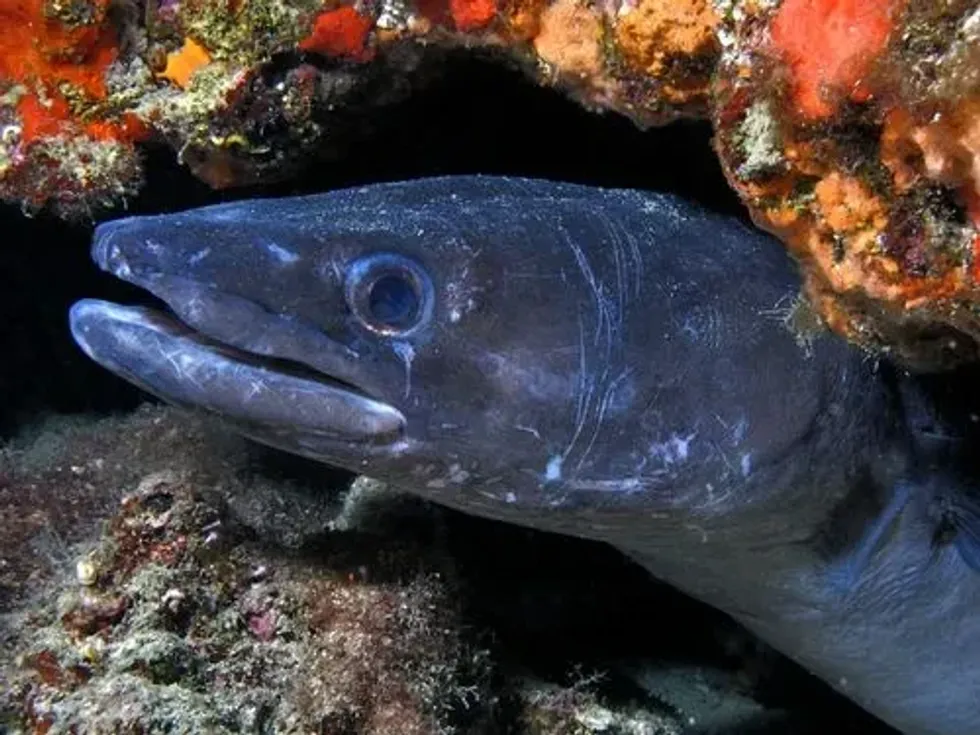The conger eel belongs to the Animalia kingdom from the family Congridae.
Its binomial name is Conger conger and congers are animals that usually prefer deep oceans and seas and are found in the North Atlantic Ocean, the Black Sea, the Mediterranean, and the Atlantic from Cape Cod in Massachusetts to northeastern Florida in the United States and the northern Gulf of Mexico.
They are slippery and are one of the smoothest marine animals with blue, black, and greyish skin color.
Congers are adorable fish, and they help enhance the beauty of the marine environment and the wildlife around them. They live in dark underwater areas like within shipwreck, holes, and caves, and they usually hunt during nighttime and prey on smaller fish.
The average litter size of this eel is between three and eight million eggs, and these fish can be dangerous to human beings. Congers are often used as food in many areas too!
You can also read our articles on the ray or the chum salmon for more great animal facts.
Conger Eel Interesting Facts
What type of animal is a conger eel?
Conger eels look a little like snakes, but they are fish. They are considered fish because they have many of the common features of fish such as large heads, fins, wide mouths, large gill slits, and strong teeth.
They are very slippery creatures, generally found in the Indian and western Pacific oceans, the Caribbean, the Atlantic Ocean and, the eastern Pacific Ocean. They are also known as 'congrios' in Mexico.
What class of animal does a conger eel belong to?
Conger eels belong to the Actinopterygii class of the Congridae family. This category includes around 194 species in 32 genera.
How many conger eels are there in the world?
The exact population of these eels is not officially recorded, we do know that they are marine animals that usually love to be in the deep waters of the ocean. They can be spotted in North America, in northern European regions, the Atlantic Ocean, the Pacific Ocean, and in Indian Ocean territories.
Where does a conger eel live?
The conger eel species love deep water.
The giant conger eel lives in deep waters in the ocean or sea, but, on the other hand, young conger eels live near to the coast and shift to the deep water after growing up. Eels of this species from the Congridae family are found in different water bodies in the world.
The conger eel is spotted in many oceans, such as the Atlantic Ocean, Pacific Ocean, and seas off the coast of India, Africa, and more.
The European conger is a species of this eel that is found in the North Atlantic Ocean, the Mediterranean Sea, and the western Black Sea, also in the Canary Islands, the Azores, and Madeira.
The European conger eel species is shy and is mostly active at night. American congers, also famously referred to as American eels, are found in the Western Atlantic, right from Massachusetts' Cape Cod to the northeast of Florida and the Gulf of Mexico.
Rumors also say that they are also located in the mid-Atlantic island of St. Helena and by the coastline of Canada's Nova Scotia.
What is a conger eel's habitat?
These slippery blue-colored eels love deep waters. This eel species is generally found in the Mediterranean Sea, and the Black Sea, (these eels are from Europe), and the American conger is located in Western Atlantic areas.
Some rare species can also be found on the coast of Africa. Congers are found in deep water in caves or reefs, rocks, or near shipwrecks deep down in the ocean.
Congers usually come out in search of food and sometimes hunt in open water too.
Their habitat also influences their behavior, as congers live in deep waters and don't get much sunlight they act both as hunters and scavengers. Congers usually come out from their cave during nighttime, hunting and feeding themselves as nighttime is a safer time, with a lower risk of being caught by predators.
Conger also don't migrate. They live within their territories, leaving only to go out in search of food. These eels can be found in the top three ocean levels: the epipelagic, the mesopelagic, and the bathypelagic layers. Their overall habitat, however, is under threat due to over-fishing and increasing temperatures.
Who do conger eels live with?
A group of eels is known as a 'swarm'. The European conger eel usually prefers living alone, and this matches up with the wider experience of most other eel species, who tend to also prefer to live alone. The European conger and other conger eels also usually hunt their food alone, mostly during nighttime.
How long does a conger eel live?
The life span of a conger eel is between nine and 21 years. Their life span depends on the habitat they are living in. Conger eels don't have many predators or any specific threats, but conger eel fish living in freshwater may be affected by water diseases and are at risk of being caught by bigger fish.
How do they reproduce?
The female conger fish releases eggs after she reaches sexual maturity. After this, the male conger eel fish fertilizes the eggs. After mating and laying eggs both adult conger eels die and eventually, the eggs hatch into larvae that make their way out, floating to the surface.
What is their conservation status?
The IUCN classifies the conger eel as Least Concern. This suggests that their population is under control with no major threats at the moment.
Conger Eel Fun Facts
What do conger eels look like?
Conger eels, with their slippery and scaleless skin, look a little like snakes but they have a prominent fin that runs along the length of their back. They are part of a group of ray-finned fishes and conger eel fish usually survive at moderate temperatures.
They are found in blue, black, and greyish colors and these eels weigh around 159 lb (72 kg) and are 5-7 ft (1.5-2.133 m) long.
Their back fin usually connects with the tail fin and the conger has an enormous head, big gills, a big mouth, and very strong teeth.
Conger eel teeth are very sharp too, and they use this to their advantage while feeding or hunting their prey. European congers are the biggest eels among this species and Europe and Africa are both known for having a large number of these beautiful species in their waters.

How cute are they?
Their shiny and colorful body can make them kind of cute. Congers have slippery, greasy, and scaleless body structures with perfect tail structure and sharp teeth though, that can make them look quite menacing too!
How do they communicate?
How the conger eel communicates underwater with its own and with other species is yet to be studied.
How big is a conger eel?
The electric conger can grow up to 8 ft (2.44 m) long. The average length of conger eels is 5-7 ft (1.5-2.133 m) long and the average weight is about 159 lb (72 kg).
How fast can a conger eel swim?
American conger can swim up to 2.42 mph (3.9 kmph). They have certain similar features to fish and can only survive underwater, so they use this speed to prey on fish and small worms when hunting, usually at night. They also swim at their maximum speed in order to keep themselves safe from being caught by predators when needed.
How much does a conger eel weigh?
The conger eel is a slippery, smooth, and scaleless species that generally weighs up to 159 lb (72 kg). The European conger is the heaviest eel, weighing about 240 lb (110 kg).
What are their male and female names of the species?
There are no specific or different names of males and females of this eel species. However, the gonad is the main feature from which you can differentiate between them.
If the gonad of the eel has a distinct lobed or scalloped appearance, then it is a male eel, and if the gonad is more like a ribbon, then it is a female eel.
What would you call a baby conger eel?
A baby conger eel is known as a 'larval'. A young eel is also known as an 'elver'.
They are transparent and flat, usually about 3.9 in (10 cm) long. They live near the coast when they are young, and after becoming adults who can protect themselves, they swim into the deep oceans and seas instead, away from the coast.
What do they eat?
They are one of the more dangerous marine animals and they are strictly carnivorous. They feed on fish, cephalopods, and crustaceans. They usually live in dark places and hunt during the nighttime.
Do they bite?
Congers are barbarous animals with large jaws and sharp teeth. They are always ready to hunt any types of fish or animals that get into their territory, and yes, they do bite. They eat anything that swims or crawls, except for creatures too big to fit in their mouth.
Would they make a good pet?
Conger eels are not a common pet as they are very dangerous fish and have been known to attack humans.
Did you know...
One of the most interesting facts about the conger eel is that they can grow as long as a basketball pole!
Congers also have small eyes and a good sense of smell which helps them in hunting. They also have gills which are located behind the head.
Fishing of conger eels is highly popular due to the meat's strong taste and nutritional value. Conger eel fishing involves using live fish as bait.
Fishing for conger eels
Have you ever caught fish? The best way to catch a conger fish is by using a live fish, such as mackerel. You can also use squid, lobsters, and crabs as bait. The biggest conger eel caught was a gigantic eel that weighed about 350 lb (159 kg), found in Iceland's Westmann Islands.
Do people eat conger eels?
Conger Eels have poisonous blood, which can sometimes be harmful or dangerous to humans to eat, but with proper cleaning and cooking methods, they can be safe to consume. These eels contain a good amount of calcium, magnesium, potassium, selenium, manganese, zinc, and iron.
They have a good taste too, with a nice, soft chewable texture. They are also fantastic sources of healthy omega-3 fatty acids. The conger eels' strong taste is said to work well with wine, garlic, and paprika.
Here at Kidadl, we have carefully created lots of interesting family-friendly animal facts for everyone to discover! Learn more about some other fish, including the cichlid or the convict cichlid.
You can even occupy yourself at home by drawing one on our Conger Eel coloring pages.










